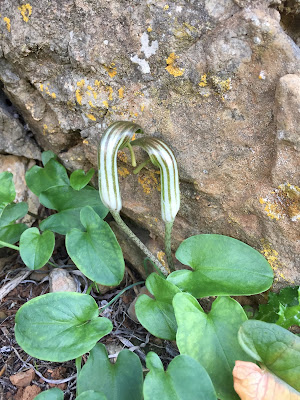

Length: ~10 km (6.2 miles)
Duration: ~5 hours walking time, includes exploring and eating lunch at the Canal Grande di Nebida
Elevation: total gain 935 m (3,070 ft), starting/ending 42 m (140 ft), max elevation 327 m (1,070 ft)
Location: Italy, Sardinia, Carbonia-Iglesias, Porto Flavia
For our first hike of the year, we found ourselves on the west coast of Sardinia hiking part of Il sentiero miniere nel blu. First, let’s tackle the trail name. This area is known for its mines (miniere in Italian) and in fact the trail goes past and over former mining sites. The word miniera (plural miniere), also means a treasure trove or wealth, which I’m guessing is used as a play on words here in that the trail takes hikers through a wealth of beautiful scenery. Sentiero means trail. And blu means blue, referring to the ocean and sky.
We parked just outside of Masua, in the parking for Porto Flavio. (We didn’t actually visit the Porto Flavio mine.) We did a loop hike, counter-clockwise. We took the inland trail north to the Canal Grande di Nebida and then took the coast trail (Il sentiero miniere nel blu) back south to the car. Specifically, from Porto Flavio parking we followed something called Bega sa canna until we hit trail 309 and then took trail 307 back south. Trail 307 is il sentiero miniere nel blu. We saved the coast trail for later in the afternoon to take advantage of the better light from the side, instead of overhead.
We got a late start having stayed up late for New Year’s Eve, and then there was an hour and a half drive from Cagliari to the trailhead. Therefore, we didn’t start hiking until noon. We didn't have much daylight so didn’t continue on to Cala Domestica, a few kilometers north of Canal Grande, which would have been an easy destination.
Flora and fungi
The ecosystem of the hike is maquis shrubland or in Italian: macchia mediterranea. We saw Arbutus unedo [Ericaceae], Cistus spp. [Cistaceae], Euphorbia dendroides [Euphorbiaceae], Juniperus spp., Pistacia lentiscus [Anacardiaceae], and Rosmarinus officinalis [Lamiaceae] to name just a few. Other plants that caught our eye:
- Arisarum vulgare [Araceae] – These were quite prolific along trail 307, and in bloom.
- Arum pictum [Araceae] – Unfortunately, we saw just leaves.
- Geastrum fimbriatum [Geastraceae] – A peculiar star-shaped fungus we spotted.
- Asphodelus spp. [Liliaceae] – At least that's what all these leaves look at. Now blooms to verify.
Some plant resources that were useful to us when researching plants we saw on this hike:
- www.atlantides.it/piante-caratteristiche-della-sardegna - This is a good starting point because it includes finding plants by image.
- luirig.altervista.org - This is a good reference if you know the family and genus name already.
- www.sardegnanatura.com/flora-sardegna.html - A good reference for different vegetation zones and the plants found in each zone, as well as different lists of plants found in Sardinia.
- www.sardegnaambiente.it/foreste/flora_fauna/flora/ and www.sardegnaflora.it - Both contain good list of plants, but you need to know what you are looking for to see plant information and photos.
Canal Grande
As noted above, we took the inner route to arrive at Canal Grande and as we walked we were wondering if we’d get to see anything special. But when we arrived at the Canal Grande beach we were not disappointed, not to mention the walk back along the coast.
To clarify – because we wondered – canale means “valley” in the Campidanese Sardinian language. You walk down a long valley to approach the water. When you reach the water, there is water access, but not a beach. The most striking aspect of the area are the rock layers, which are arranged almost vertically. Then, there is the natural sea cave called La Grotta del Canal Grande. Inside and under the right light, you will see the intense blue of the water and the purple of algae and sea urchins clinging to rocks, tantalizingly out of reach. Nearby the opening of the sea cave, we found a pile of sea urchin shells, ones that were in reach and now in someone’s belly, or at least their gonads were.
According to the Sardegna Natura site, sphalerite was once mined in this area.
Left: Arisarum vulgare. Center: Arum pictum. Right: Rosmarinus officinalis.



Left: Cistus spp. Right: Pistacia lentiscus.


Left: Signs for trails 307 and 309. Right: Information sign at Canal Grande di Nebida.


Left: Sea cave at Canal Grande with blue and purple colors. Right: Sea urchin shells.


"Beach" at Canal Grande di Nebida.

Views along the Sentiero miniere nel blu. Right: Note numerous lily (asphodelus) plants, if that is what they are indeed.


Start of hike near Porto Flavio.


Left: Sign explaining trail 309. Right: Crab at Canal Grande.


Photos from our better camera.
The photos above were all taken with cell phones (except the crab photo). The following photos were taken with a Canon 7D and you can see the difference.Left: Bee on Rosmarinus officinalis. Right: Arbutus unedo fruit.


Left: Arisarum vulgare. Right: Geastrum fimbriatum.


Left: View north along the Sardinia west coast near Nebida. Right: View down on the sea cave at Canal Grande.


Left: View south along the Sardinia west coast toward Nebida. Right: View of Pan di Zucchero Masua.


Left: Pancratium illyricum leaves. Right: View of maquis shrubland.


Left: Sea cave at Canal Grande. Right: Shallow water at Canal Grande.


No comments:
Post a Comment
All comments are moderated. If your comment doesn't appear right away, it was likely accepted. Check back in a day if you asked a question.